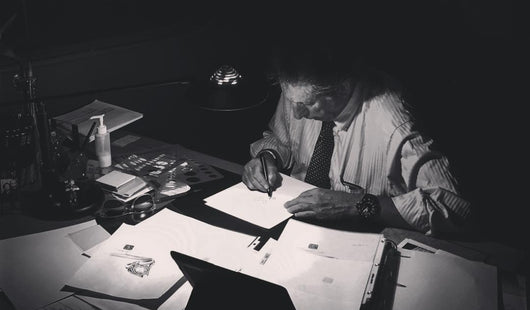Best Choice for Engagement Ring: Platinum vs. 18-Karat Gold

The search for the ideal engagement ring doesn’t end when you find the perfect diamond. Choosing the right metal is just as essential to creating a ring that’s timeless, durable, and reflective of your unique love story. Platinum and gold remain the most popular choices for engagement rings. Understanding the differences can help you make a confident, informed decision, so let's look at how each compares in appearance, durability and comfort.
Appearance
Color is a major distinguishing characteristic between platinum and gold. While the latter is naturally yellow, the former is white. If you prefer a yellow ring, gold will always be the best option. If you want a white ring, on the other hand, you can choose either platinum or white gold.
Composed of gold, alloys, and rhodium plating, white gold looks very similar to platinum. 18k yellow gold and 18k white gold have the same gold content and purity, but the alloys used in white gold (and the rhodium plating) give it a lustrous white appearance.
While it looks quite similar to platinum, white gold’s rhodium plating will wear and turn yellowish over time. Once you re-plate and re-polish a white gold ring, however, it will regain its white appearance. Platinum, on the other hand, is naturally white, meaning it will never fade to yellow.
Density
While platinum and gold are similar in price per gram, it takes more platinum to make a ring because the metal is denser. Platinum rings are also usually 95% pure platinum, while 18k gold is only 75% gold. Since it's less malleable, platinum is harder to mold, so the cost of labor that goes into shaping a piece increases.
Durability
Although platinum and gold are both strong precious metals, platinum is the more durable of the two. The prongs holding the center gemstone of a platinum ring are much less likely to break compared to those of a gold engagement ring.
Despite being more durable, however, platinum will get scratched more easily than gold. That said, when platinum is scratched, the color shifts within the ring, generating what is known as a patina finish. In many cultures, this is a beautiful occurrence viewed as a symbol of how long you and your partner have been together. In the United States, opinions differ from person to person, but many people love and embrace the platinum patina.
Whatever the case, both platinum and gold rings can be professionally re-polished to restore their original luster. And with expert craftsmanship from John Atencio, you can be confident that your ring—regardless of metal—will be beautifully made and built to last.
Care and Maintenance Tips
Caring for your engagement ring is key to preserving its beauty and brilliance, whether it’s made of platinum or gold. Here’s how to properly maintain both types of rings:
General Ring Care
Store rings separately in a soft pouch or fabric-lined box to avoid scratching. Remove rings during hands-on activities like gardening, cleaning, or lifting weights. You should also have your ring professionally cleaned and inspected every 6–12 months.
John Atencio offers free inspections and professional cleanings for all John Atencio jewelry. Simply contact a nearby location to schedule an appointment.
Platinum-Specific Care
Clean with mild soap and warm water, then dry with a soft cloth. Understand that patina (a soft matte finish) will develop over time—some love it, others prefer to polish it out. Minor scratches can be buffed by a jeweler; deeper marks may require professional polishing. Bear in mind that platinum does not require re-plating like white gold.
Gold-Specific Care
Clean with a soft brush, mild soap, and lukewarm water. Avoid harsh chemicals like chlorine or bleach, which can weaken gold. If gold prongs bend or wear down, a jeweler can replace or repair them. Remember that white gold needs rhodium re-plating every few years to maintain its bright white shine.
Listen to our podcast episode on Engagement Rings
Platinum vs. Gold: Which is Best?
While both types of precious metals are beautiful, each has its own distinctive benefits, including:
Platinum
- Requires less frequent polishing
- Extremely durable
- Naturally white (no plating required)
- More valuable per gram due to higher purity
Gold
- Slightly shinier in appearance
- More affordable than platinum
- Lighter and more comfortable
- Available in yellow, white, and rose hues
- The most popular engagement ring metal worldwide
While some regard platinum as more hypoallergenic than gold, it’s important to know that John Atencio's 18-karat white gold is alloyed with palladium, creating a hypoallergenic, super-white, nickel-free design that won’t irritate sensitive skin.

Which Metal Is Right for You?
Not sure which metal to choose? Here’s a helpful guide to determine what’s best based on your lifestyle, preferences, and priorities:
Platinum
-
Ideal for active wearers—more durable
-
Timeless, elegant, understated
-
Extremely durable, develops a patina
-
Heavier and more substantial
-
No re-plating required
18K Gold
-
Better for less active wearers—lighter
-
Versatile—modern or classic
-
Durable but requires occasional maintenance
-
Lighter and more comfortable for daily wear
-
White gold needs re-plating every few years
When deciding between each option, it can help to ask yourself the following questions:
-
Do I prefer a lightweight or a heavier ring?
-
Is long-term durability a priority?
-
Am I prone to skin sensitivities?
-
Am I planning to invest more in the setting or the diamond?
-
Do I love the idea of a ring that tells a story over time (patina) or one that shines bright with regular upkeep?
Your answers to these questions can help you make the perfect choice, and the expert team at John Atencio is always available to answer questions and help guide your decision.
FAQs About Platinum vs. Gold for Engagement Rings
Q: Does platinum scratch more easily than gold?
A: Yes, platinum can scratch more easily—but unlike gold, it doesn’t lose metal when it’s scratched. Instead, it displaces, creating a patina finish that many people love.
Q: How often does white gold need to be re-plated?
A: Every 1–3 years, depending on how often you wear the ring and your activity level. Rhodium plating keeps white gold looking bright and reflective.
Q: Can you resize a platinum or gold ring?
A: Yes, both can be resized by a skilled jeweler. However, resizing platinum is more labor-intensive due to its density.
Q: What are the main differences in appearance between platinum, white gold, and yellow gold?
A: Platinum and white gold look similar at first, but platinum retains its white hue, while white gold may yellow over time without re-plating.
Making Your Final Decision
When it comes to choosing between platinum and 18-karat gold, there’s no universal “best” choice—only what’s best for you. Both are luxurious, time-tested metals with their own sets of strengths. Platinum offers unmatched durability and a rich, hypoallergenic composition. Gold, on the other hand, provides classic shine, variety, and affordability.
When it comes to choosing between platinum and gold, personal preference plays a big role. At the same time, 18K white gold might be the better choice if you are on a budget and want to maximize other aspects of your engagement ring. For instance, you could put the extra money toward a better diamond or a more intricate setting.
If, however, you or your partner has a preference for platinum, there is good reason to embrace the metal. After all, a gold ring is generally a less valuable commodity than a platinum ring because of its lower purity. Even though the absolute raw value of platinum and pure gold are almost equal, lower purity dictates lesser value to a large extent.
With all that said, platinum isn't necessarily better than gold—it's all about your personal preferences and priorities.
John Atencio’s experts can help you choose the perfect engagement ring for your special someone. Visit one of his many convenient locations and let his attentive experts guide you toward a breathtaking symbol for your one-of-a-kind love story.


